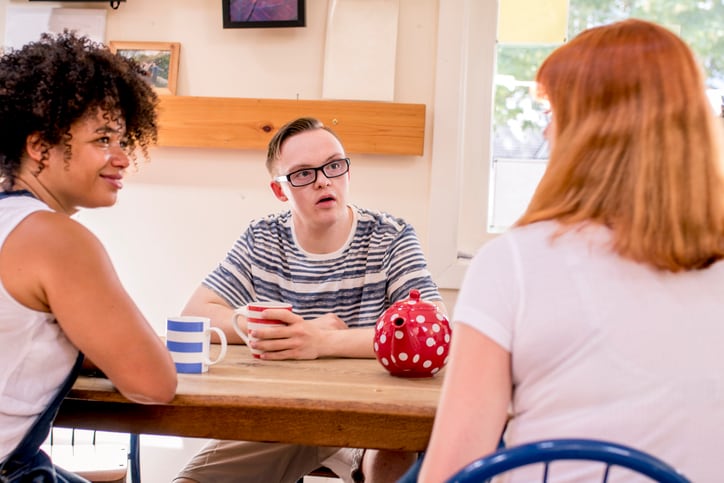If you’re caring for an adult with disabilities and exploring long-term options, you may have come across the term “adult family home.” These small, licensed residences — often regular houses in residential neighborhoods — provide care and daily support for a few adults who don’t need hospital-level care but still require help to live safely and comfortably.
“All parents, regardless of special needs, want their children to be as independent as possible, and adult family homes can help support that,” says Jennifer Szakaly, a gerontologist and certified care manager in North Carolina. “Someone with a disability can live in this type of home for decades, so we help families create care plans that reflect their loved one’s needs and goals — even after they’re no longer able to do it themselves.”
Here’s what to know about adult family homes, including how they work, who they’re for, what they cost and how to find the right fit.
Key takeaways
- Adult family homes provide daily support in a home-like setting for adults with disabilities or older adults who need help with daily living.
- Monthly costs typically range from $3,500 to $5,000. Medicaid waivers may cover care services — but usually not room and board.
- Access and coverage depend on your state. Long waitlists and proposed Medicaid cuts could make community-based care harder to find.
- Start early and ask detailed questions to improve your chances of finding a home that fits your loved one’s needs and your budget.
What is an adult family home?
An adult family home is a small, licensed residence where a few adults live together and receive daily support from trained caregivers. Often located in regular neighborhoods, these homes offer a more personal, home-like alternative to larger facilities like assisted living or nursing homes.
They’re best suited for people who don’t need medical care around the clock but still need help with daily tasks like bathing, meals and mobility. Many adult family care homes are run by individuals or families who live on-site or manage a small caregiving team, creating a consistent and familiar environment.
Names for this model vary by state — such as adult foster care, adult residential care home, adult developmental home or adult care home. This can make navigating options more confusing. But the goal is the same: to help adults live with more independence, dignity and comfort in a setting that feels like home.
“We like to consider our adult family homes forever homes. People usually stay unless they need nursing care or their family wants them closer. It really depends on the individual’s abilities and needs.”
— Lillian Short, director of development, Balance, Inc.
Who is an adult family home best for?
Find adult care.
Adult family homes are a good fit for people who need daily support but still want to live in a home-like environment — not an institution. These homes are often a lifelong option for adults with disabilities or chronic health needs.
They may be a good choice for adults who:
- Have disabilities, cognitive differences or chronic medical needs.
- Need help with daily activities like bathing, dressing, meals or mobility.
- Prefer a quieter, more personal setting than a large assisted living facility.
- Want to live more independently but still need some level of supervision.
- Thrive with consistent routines and close relationships with caregivers.
“We like to consider our adult family homes forever homes,” says Lillian Short, director of development at Balance, Inc., a Wisconsin-based nonprofit that offers both residential and supported living options. “People usually stay unless they need nursing care or their family wants them closer. It really depends on the individual’s abilities and needs.”
Balance also offers flexible programs — like drop-in support with groceries, bills or transportation — for adults who don’t need full-time residential care. “It’s wildly dependent on the person,” Short adds. “We try to meet people where they are.”
A growing number of adults entering these homes are younger. According to the Kaiser Family Foundation (KFF), more than half (56%) of Medicaid enrollees who use long-term services and supports are under age 65 — and 70% of those qualify due to a disability.
Nick Steck, a 35-year-old man with Down syndrome and autism, lives in one of Balance Inc.’s adult family homes. His father, David, says it’s given him a sense of independence. “I pick him up every weekend and we do things together,” he says. “But living there has given both of us a great sense of balance. It’s been a truly great experience.”
How much does an adult family home cost?
Cost is often the biggest concern for families considering an adult family home. On average, monthly fees can range from $3,500 to $5,000, depending on location, the level of care provided and whether the room is private or shared. This typically includes housing, meals, supervision and help with personal care.
“Out-of-pocket costs can add up quickly. For many families, affordability is the biggest factor in whether this kind of care is even possible.”
— Megan McVane, social worker
However, these homes can still be financially out of reach for many — especially those without long-term care insurance or private savings. While Medicaid can help, it usually only covers care services, not room and board.
Common ways families pay for adult family home care
- Private pay (out-of-pocket).
- Medicaid waivers (covers care services only, not housing).
- Supplemental Security Income (SSI).
- Optional State Supplements (OSS).
- Family contributions.
- Long-term care insurance.
- Veterans benefits.
“Out-of-pocket costs can add up quickly,” says Megan McVane, a social worker who oversees home-based care for veterans in Illinois. “For many families, affordability is the biggest factor in whether this kind of care is even possible.”
What about adult family home care for veterans?
The U.S. Department of Veterans Affairs (VA) offers a program called medical foster homes, which is their term for the “adult family home” model of care. But the VA doesn’t directly pay for these homes. To qualify, veterans must be enrolled in the VA’s Home-Based Primary Care program, and an approved foster home must be available in the area.
“Some states have more homes than others,” McVane notes, referencing the VA’s limited list of locations.
Nonprofit adult family homes face added funding challenges
In nonprofit models like Balance, Inc., the cost burden is even more complicated. Unlike for-profit adult family homes that can often negotiate higher Medicaid reimbursement rates, nonprofits must work within tighter budget constraints — and typically do not receive the same flexibility in funding.
“Balance’s residents use their disability benefits, so SSI and Medicaid are where most of the funding comes from,” Short says. “Their SSI pays for room and board and Medicaid waivers pay for care and supervision.” That means staff at Balance often turn to donors or fundraisers for things like home maintenance, community outings and activities, and accessible appliances that promote greater independence.
Adult family care homes: State-by-state differences
Access to adult family homes and what Medicaid covers varies widely depending on your state. Different names, rules and funding levels can make it difficult to know what’s available or affordable where you live.
How it looks in different states
- Washington has more than 3,200 licensed adult family homes, leading the country. Over 90% accept Medicaid, with programs like COPES and Medicaid Personal Care helping cover services.
- Wisconsin supports over 2,000 homes through Family Care and IRIS waivers. IRIS allows people with disabilities to choose how and where they receive care.
- Illinois offers a Supportive Living Program that blends housing and services. Medicaid helps cover personal care, but not housing costs.
- Texas calls this model “adult foster care” and limits each home to three residents. Their STAR+PLUS program pays for personal care but not room and board.
- California expanded its Assisted Living Waiver to 15 counties in 2024, creating 7,000 new slots. Still, access depends on where you live.
- North Carolina refers to these as “adult care homes” and offers support through Medicaid’s Innovations Waiver—but more than 18,700 people with intellectual or developmental disabilities are on the waitlist, according to the state’s own Innovations dashboard. Families may wait over 13 years, depending on inconsistent state funding.
“Housing is one of the biggest challenges families face,” says Szakaly. After seeing the limited options in her home state of North Carolina and an increase in families reaching out to her firm, Caregiving Corner, for help, she decided to open two of her own adult care homes. “I want to change the quality of care one house at a time.”
“…when I see Nate’s smiling face doing something he loves, I know I made the right choice.”
— Meredith Zopf, sibling of an adult family home resident
How to find the right adult family home
Choosing the right home takes time, and Medicaid-contracted homes often have long waitlists. These tips can help you navigate the process with more confidence and clarity:
1. Start early to avoid waitlist stress
Many homes — especially those that accept Medicaid — fill up quickly. Starting your search well in advance gives you more options and helps you avoid having to make decisions during a crisis. For example, when Meredith Zopf’s parents passed away within months of each other, she and her two sisters needed to find a new living arrangement for their brother, Nate, who had lived with them for 38 years.
“I called every adult family home on the list and toured half a dozen, but nothing felt like the right fit,” she says. Then, she widened her search and found Balance — and they happened to have a rare opening. “It was one of those moments where it felt like the heavens opened and the angels started singing,” she remembers. “I thought, ‘This is it; search over.’ And when I see Nate’s smiling face doing something he loves, I know I made the right choice.”
2. Tour in person when you can
Websites and brochures only show part of the picture. A visit helps you get a sense of the home’s environment, how caregivers interact with residents, and whether it feels welcoming and safe.
3. Ask detailed questions
Bring a checklist and ask about:
- State licensing and inspection status
- Number of residents and staff ratios
- What’s included in the monthly fee
- How the home supports specific disabilities or behaviors
- Emergency plans and overnight staffing
- Whether they accept Medicaid, and what’s out-of-pocket
4. Talk with other families and support networks
Connecting with families whose loved ones live in the home or with local disability groups can give you honest insights into what daily life is really like.
5. Know your state’s terminology
“Adult family home” may not be the official term where you live. States use different names — such as adult residential care home, adult developmental home or adult care home — which can make it harder to search for options or understand what’s covered.
6. Start with your state Medicaid office or Area Agency on Aging (AAA)
These agencies can help explain local terms, Medicaid waiver eligibility, and what facilities are currently accepting new residents. While there’s no national database for Medicaid-contracted adult family homes, many local AAA offices maintain helpful lists.
A final word on adult family home care
Adult family homes provide a safe, supportive alternative to institutional care — offering daily assistance in a more personal, home-like setting. They can be a great fit for adults with disabilities who want more independence but still need help with everyday tasks.
Access depends on where you live, whether the home accepts Medicaid and what you can afford. Long waitlists and potential Medicaid cuts are making it harder for families to find care, even when it’s the right fit. That’s why experts recommend starting early and asking detailed questions.
“It’s fulfilled my dream because I know that my brother is in an environment that’s supportive, nurturing and allows him to be himself,” says Zopf. “He’s making new friends, trying new experiences — that dream has really flourished.”





